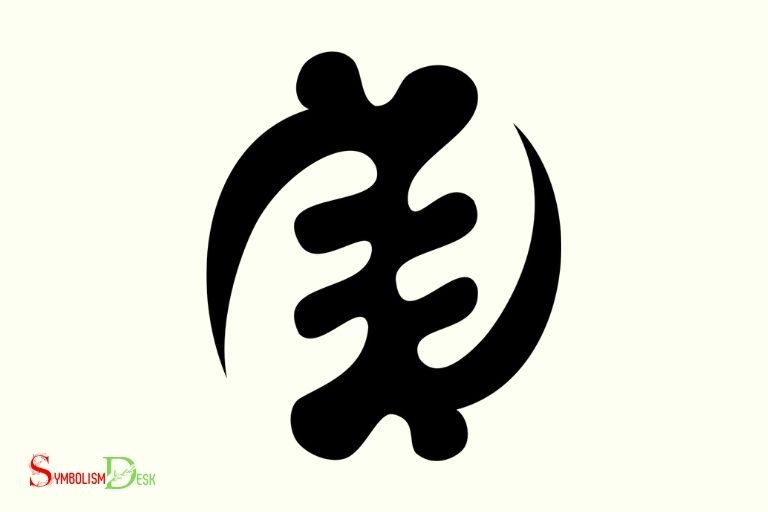What Does the Gye Nyame Symbol Mean? Supremacy of God!
The Gye Nyame symbol represents the supremacy of God in the Akan culture of West Africa.
Gye Nyame, derived from the Akan language in Ghana, translates to “except for God” or “there is nothing greater than God.”
This symbol is widely used by the Akan people, and it signifies their belief in a supreme being who is omnipotent and omnipresent. The Gye Nyame symbol embodies their faith, spiritual connection, and reliance on God in all aspects of life.
Gye Nyame has become an important cultural symbol not only for the Akan people but also for Africans and African descendants worldwide.
The presence of this symbol in various forms of art, such as traditional pottery, clothing, and wood carvings, emphasizes the deep spiritual connection and reverence for God within the Akan community.
By embracing the Gye Nyame symbol, one acknowledges the belief that there is no force or power greater than the divine.
8 Symbolisms Meaning of the Gye Nyame Symbol
| Meaning/Symbolism | Description |
|---|---|
| Supremacy of God | “Gye Nyame” translates to “except for God” or “only God.” It represents the omnipotence and supremacy of the Divine in all aspects of life. |
| Divine Providence | Signifies the belief in the Divine’s control over human destiny and the acknowledgement that human actions are subject to God’s will. |
| Faith and Trust | Encourages faith, trust, and reliance on God’s guidance and providence in navigating life’s challenges. |
| Humility | Reflects the Akan value of humility, as it reminds individuals of their dependence on a higher power and their place within the broader cosmos. |
| Spiritual Connection | Represents a deep connection to the spiritual realm and a reminder of the presence of the Divine in daily life. |
| Cultural Identity | Serves as a symbol of cultural heritage and identity for the Akan people and is often used in visual art, clothing, and jewelry. |
Key Takeaway

Five Facts About: The Gye Nyame Symbol’s Meanings
The Origin Of Gye Nyame: A Brief Historical Overview
The gye nyame symbol is a well-known west african adinkra symbol that originated from the ashanti tribe in the early 16th century.
It represents the supremacy of god in the beliefs of the ashanti people, and its meaning is widely recognized throughout ghana, where the ashanti tribe is predominately located.
A Short History Of The Ashanti Tribe And Ghana During The Early 16Th Century
- The ashanti tribe is one of the ethnic groups of ghana, located in the central part of the country.
- The ashanti kingdom was established in the 1670s in the ghanaian forest region.
- The kingdom grew significantly in power and wealth through the 18th and 19th centuries, becoming one of the most influential empires in west africa.
- During the early 16th century, the ashanti tribe believed in multiple gods and goddesses, and every individual was responsible for their spiritual wellbeing.
The Significance Of The Emergence Of The Gye Nyame Symbol
- The ashanti tribe has a long and rich history of using symbols to express their beliefs and way of life.
- The emergence of the gye nyame symbol represented a shift in the belief system of the ashanti people.
- The symbol signifies the belief that god’s supremacy is above everything and that everything is dependent on god.
- The gye nyame symbol can be found everywhere in ashanti culture, from clothing to home decor and even on billboards in modern-day ghana.
How Did The Symbol Come Into Being?
- The gye nyame symbol was created by a goldsmith and a member of the ashanti tribe.
- The goldsmith’s name was akwasi asare, and he created the symbol during ghana’s ashanti kingdom, which was located in the forest region of ghana.
- The symbol was created using the adinkra printing technique, which originated in ghana.
- The gye nyame symbol quickly became popular due to the deep meaning it conveyed and was widely used in various artforms.
The gye nyame symbol has grown from a small symbol used by the ashanti tribe in ghana to a symbol that represents the power and supremacy of god for numerous individuals around the globe.
It is a testament to the rich culture and heritage of ghana, as well as the ingenuity and creativity of its people.
Deciphering The Meaning Of Gye Nyame: What Does It Represent?
The gye nyame symbol is an iconic adinkra symbol used by the akan people of ghana. It is a beautiful representation of a unique african philosophy.
It is a symbol that transcends religious, political, and ethnic boundaries and represents the power of the supreme being in all things.
The following are the key points that will help to unravel the meaning of the gye nyame symbol.
An In-Depth Look At The Literal Meaning Of Gye Nyame
The gye nyame symbol is comprised of two main elements: a stylized depiction of a crocodile and the phrase “gye nyame,” which translates to “except for god” or “only god. “
- The phrase is composed of two akan words, “gye” meaning “except” or “but” and “nyame” meaning “god”.
- The stylized crocodile in the center of the symbol signifies strength and adaptability, as the crocodile is a creature that can survive in both water and on land.
The Significance Of The Features Of The Gye Nyame Symbol
Each element of the gye nyame symbol is rich in meaning, and they work together to represent the power and importance of god in all aspects of life.
- The crocodile, as mentioned above, represents strength and adaptability, qualities that are essential for survival.
- The use of gold in the symbol represents the precious nature of god’s power and the importance of spirituality in the daily lives of the akan people.
- The use of the akan language in the phrase “gye nyame” reinforces the cultural significance of the symbol and the strong ties between spirituality, language, and culture for the akan people.
How Is The Symbol Used In African Culture?
The gye nyame symbol is a popular symbol in african culture and is often used in various forms of art, clothing, and jewelry.
It is a symbol of pride and unity for the akan people, but it also has broader significance in african culture as a whole.
- The symbol has been used in various afrocentric movements that aim to celebrate african culture and promote unity among people of african descent.
- The symbol has also been used as a tool for resistance against colonialism, a reminder to african people of the power and resilience they possess.
- Today, the symbol is still widely used and can be seen on flags, stamps, and coins across africa, reminding people of the importance of spirituality, strength, and adaptability in their lives.
The gye nyame symbol is a beautiful representation of the akan philosophy that acknowledges the power of the supreme being in all things.
Its use of powerful imagery and language makes it a symbol that transcends boundaries and has significance beyond just the akan people.
The Spiritual Significance Of Gye Nyame: Unpacking The Symbolism
The Prominent Spiritual Symbolism Of Gye Nyame
Gye nyame is a symbol in the akan language of west africa that translates to “except for god. ” It is often referred to as the adinkra symbol and represents the omnipotence of god.
The symbol is made up of a circle with a unique design; it features a smaller circle within it, with a distinct pattern that conveys a special meaning.
Understanding the spiritual symbolism of gye nyame is essential in grasping the akan religion and its spirituality.
Here are some of the significant spiritual symbolisms of gye nyame:
- Gye nyame highlights the belief that god is the ultimate power, and nothing should be compared to him.
- It captures the idea that god knows everything and possesses infinite knowledge.
- The symbol signifies that god is ever-present, omnipotent and he is the source of all things.
- Gye nyame carries an emphasis on humility in expressing that every living being is beneath god.
The Importance Of The Symbol In African Religion And Spirituality
Gye nyame has significant importance in african religion and spirituality, particularly in the akan tribe of west africa. The symbol is not only sacred, but it also carries a deep sense of cultural pride.
Below are some of the peculiar qualities that gye nyame possesses, which make it a vital part of african spirituality and religion:
- The symbol is instrumental in the akan language as it is used in most literary works of the region.
- It is featured in the akan clan’s coat of arms, which signifies a deeper spiritual connection between the symbol and its people.
- Gye nyame is crucial in akan traditional religious ceremonies where rituals are performed with the symbol.
- The symbol is present in clothing, art, and other items that are part of the akan culture.
How The Gye Nyame Symbol Played A Role In Overcoming Colonialism And Slavery
Historically, the gye nyame symbol played a crucial role in the african culture’s struggle against colonial enslavement and colonialism. During this period, the symbol gave hope to the enslaved africans and uplifted them.
Here are some ways that symbol was significant in overcoming colonialism and slavery:
- Gye nyame was a way of preserving the traditional african religion and spirituality, which was erased during the colonial period.
- African slaves in the americas and caribbean secretly used gye nyame as a way to preserve their cultural identity; they would inscribe it on pottery and other objects to transmit their cultural heritage covertly.
- The symbol acted as a form of resistance, giving hope to enslaved africans as it reminded them of their culture and spirituality, which was the only thing they had left.
The gye nyame symbol is an essential part of african religion and spirituality. Its spiritual symbolism signifies the omnipotence and greatness of god, while its cultural importance is vital in preserving akan culture and their traditional religion.
The symbol also played a significant role in overcoming colonialism by giving enslaved africans a spark of hope through its distinct messages of power, knowledge, and cultural identity.
The Cultural Transformation Of Gye Nyame: The Symbol’S Evolution In Contemporary African Culture
The cultural transformation of gye nyame: the symbol’s evolution in contemporary african culture
The gye nyame symbol is a revered symbol of the akan people in west africa. It is a powerful symbol of faith, emphasizing the omnipotence and supremacy of god. The symbol has been around for centuries and has evolved over time.
We will explore how the gye nyame symbol has transformed over time and its significance in contemporary african culture.
How The Gye Nyame Symbol Has Evolved With Time
The evolution of the gye nyame symbol began in ancient times. It has remained a significant symbol of the akan people for over 400 years. The gye nyame symbol has evolved in style and significance, adapting to the ever-changing times.
Here are some key points highlighting the evolution of the gye nyame symbol over time:
- The symbol has become more mainstream and widely recognized in recent years due to its use in popular culture.
- It has evolved in design, with artists creating variations of the original symbol with their unique styles.
- The use of new materials has allowed the symbol to be incorporated into modern art pieces, fashion, and home décor.
The Modern Usage Of Gye Nyame In Art, Fashion, And Literature In Africa And Beyond
The gye nyame symbol has become a popular cultural reference point in both africa and beyond.
Here are some key points highlighting the modern usage of the gye nyame symbol:
- The use of gye nyame in fabrics, clothing, and jewelry represents african culture and heritage.
- Artists have adapted the symbol to express their unique art styles, creating original pieces that speak to african identity.
- Contemporary literature has imbued the gye nyame symbol with fresh cultural meaning, using it in novels, poems, and films as a symbol of pride and heritage.
How Non-African Cultures Have Adopted The Gye Nyame Symbol And Integrated It Into Their Own Cultural Expressions
The gye nyame symbol has transcended borders and has been adopted by non-african cultures worldwide, where it has been integrated into their cultural expressions.
Here are some key points outlining how non-african cultures have adopted the gye nyame symbol:
- Gye nyame has been incorporated into the designs of western fashion items such as jewelry, clothes, and home décor.
- The symbols have been used in contemporary urban art and as architectural elements.
- It has become a means of cultural exchange and cultural appreciation, enhancing intercultural understanding and connection.
The gye nyame symbol’s cultural transformation is an excellent example of the significance of enduring symbols to their respective cultures and the impact they can have beyond their origin.
Its evolution, modern usage, and adoption by non-african cultures highlight its significance and impact on the world.
What Does the Circle Hand Symbol Mean in Reference to God’s Supremacy?
The circle hand symbol meaning in reference to God’s supremacy signifies the encompassing power and authority of the Divine. It represents God’s omnipresence, protection, and all-encompassing control over the universe. This symbol serves as a reminder of God’s limitless presence and ultimate reign over all creation. It embodies the belief in God’s infinite wisdom, guidance, and sovereignty.
FAQ About What Does The Gye Nyame Symbol Mean?
What Does The Gye Nyame Symbol Represent?
The gye nyame symbol represents the supremacy of god in the african akan culture.
What Does The Word Gye Nyame Means?
Gye nyame is a twi phrase that means “except for god” or “only god”.
What Is The Origin Of The Gye Nyame Symbol?
The gye nyame symbol has its origin in the ancient akan ashanti kingdom, present-day ghana.
What Is The Significance Of The Gye Nyame Symbol?
The gye nyame symbol signifies the importance of god’s supremacy and the oneness of god in the lives of the akan people.
How Is The Gye Nyame Symbol Used Today?
The gye nyame symbol is used in various forms of art, including clothing, jewelry, and home decor, to represent a connection to african heritage and spirituality.
Conclusion
The gye nyame symbol has remained an intriguing representation of the strong african cultural heritage. Through its intricate design and symbolic meaning, it offers a glimpse into the ancient african way of life.
The symbol’s meanings have been interpreted in various ways by different people, religions, scholars, and cultures. The Egyptian owl symbol meaning, for instance, is often associated with wisdom, protection, and mystery in ancient Egyptian culture. This interpretation contrasts with its representation in other societies, where it may be seen as an omen or a messenger of secrets. Such varied perspectives highlight how symbols carry layered significance shaped by cultural and historical contexts.
However, one thing remains constant: its powerful representation of the power and supremacy of god over all things.
Its use in modern society remains prevalent in various forms of art, fashion, and jewelry. This has contributed to the symbol’s continued relevance in contemporary times.
As we continue to explore different cultures and their symbols, it is vital to appreciate the significance of these ancient symbols.
They offer us an opportunity to connect with our roots and understand where we come from. The gye nyame symbol is a testament to the richness of african culture, and we should continue to preserve and celebrate its beauty and significance.






